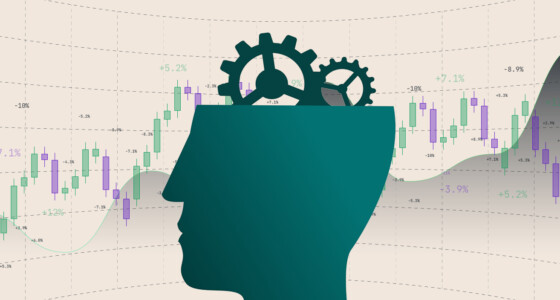

In the following article, we will discuss what a Gravestone Doji is, how it works, and how traders can use this tool to their advantage. We will also go over its drawbacks and its opposite.
Definition of gravestone doji
Gravestone Doji is a name for a negative indication that technical analysts frequently employ in trading. Whenever the open, closing, and low prices are close to one another with a long upper shadow, a Gravestone Doji candlestick pattern is created, resembling a bearish reverse candlestick structure or inverted T with a lengthy upper shadow.
The extended upper shadow indicates a bullish advance at the session’s start that the bears at the session’s conclusion have overcome. This usually occurs right before the onset of a longer-term decline.
A gravestone pattern can be interpreted as a signal to exit a bullish trade or to begin a bearish one. It is a bearish signal that indicates a turn in the market movement, accompanied by a downward trend.
What does a gravestone doji say?
Investors and traders utilize a gravestone doji in technical analysis. They base their forecasts on statistical fluctuations, like historical price movements, trade volume, and prior performance.
The gravestone doji signals an impending negative turn. The pattern can be valid if low, open, and close prices are equal or nearly equal. There should also be a reasonably short tail. Otherwise, it can be categorized as a spinning top, shooting star, or inverted hammer.
The bulls try to force the market towards new highs during the session. However, the bears drive the price action to come close to the open at the end of the session. The gravestone doji may appear after an upswing and a downturn, although it is more frequently seen towards the close of an upswing. The extended higher shadow indicates the declining bulls.
Note! Despite its popularity, the gravestone doji has the same dependability problems as many other visual patterns. Traders should only take action once the next candle confirms a turnaround.
How to trade the gravestone doji?
Even though it’s crucial to utilize this candlestick pattern in combination with other technical analysis tools as a confirmation, traders will frequently abandon long positions or start short ones after spotting gravestone doji. They often use trading volume and past performance as possible signs of the pattern’s dependability.
Whenever traders come across a gravestone candlestick at the peak of an uptrend, they should always wait for the upcoming candle to close underneath the lowest level of the gravestone candle and then go for a short-selling position.

Dragonfly doji vs. gravestone doji
Dragonfly doji is the name for a bullish pattern on a gravestone doji. It doesn’t occur very often and resembles a “T”. It usually appears when the session’s close, open and high are all identical or almost equal. The dragonfly doji has a longer lower shadow than the gravestone doji, which suggests that sellers were aggressive during the candle period.
Despite being discussed separately, these two forms are fundamentally the same occurrence. One might be labeled bullish and the other bearish after confirmation. They can occasionally be seen in the opposite situation. For instance, a bullish dragonfly could emerge before a downturn, while an upswing may accompany a gravestone doji.
Note! Both patterns require the next candle and volume for confirmation. It would be better to consider them as uncertainty visualizations instead of pure bullish or bearish indications.
Drawbacks of gravestone doji
In a downtrend, the gravestone doji may be used to propose a stop-loss location and develop a profit-taking strategy. However, these are weaker approaches regarding accuracy than those offered by other technical analysis tools. The gravestone doji is most reliable when used in conjunction with other instruments, but it also becomes more reliable when volume and confirming candle are present.
FAQs
To finally understand how the indicator works, let’s answer the most frequently asked questions about it.
What is the meaning of a gravestone doji?
A gravestone doji can be described as a pattern in technical analysis. It is a bearish pattern that appears between a reversal and indicates a price decline. Traders use it to find trading opportunities and decide when to close their trades, whether they are bullish or bearish.
How does gravestone doji work?
The gravestone doji occurs in a series of candlestick patterns: the opening, low and high prices might all be equal or almost comparable. When this happens, a new negative trend expected to emerge raises the chance of a trend reversal. After recognizing the pattern, ensure reversal is imminent to earn from the trade.
Once the subsequent candle falls underneath the gravestone doji’s closing price, you should enter a position. Place stop-loss order at the candle’s peak point, and be ready to take income. The trade can also be entered above the closing price. Make sure your stop-loss is placed at the gravestone’s lowest position before you take income.
What does a gravestone doji indicate?
A gravestone doji is a negative trend that suggests a turnaround is approaching. Traders can anticipate that the security price will go down after the reversal. Having spotted a gravestone doji, it is possible to earn by taking a bullish position or entering a bearish trade.
What’s the opposite of a gravestone doji?
A dragonfly doji is the reverse of a gravestone doji. It has a longer bottom shadow, while the gravestone doji is an inverted T with a long top shadow.
A dragonfly doji, which occurs in a slump, denotes the opposite trend, whereas one that occurs in an upswing suggests that the negative pattern could be developing. Remember that this trend doesn’t happen very frequently.
The bottom line
Many investors and traders turn to technical analysis to earn in the market and employ many instruments based on historical performance, price history, and trading volumes. The Gravestone Doji serves as one of these tools. This inverted T symbol, which shows up as a series of candlestick patterns, is bearish and suggests that the price action is undergoing a decline and indicates that a turnaround is likely. Understanding how the Gravestone Doji works, when to employ it, and how to combine it with various technical tools will enable you to limit your losses while trading.





